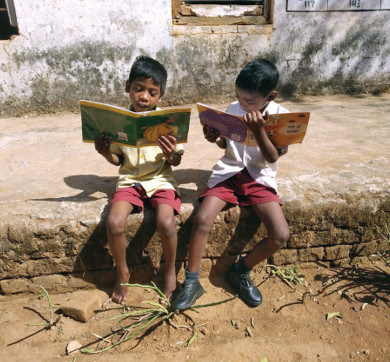December 2019 | 885 words | 4-minute read
It may be a coincidence, but the contrast is striking. Uttar Pradesh is among the lowest-ranked states in India on key educational indicators, but it has the highest number of madrasas in the country.
Madrasa — the word comes from Arabic — originally meant any kind of educational institution. These days it refers almost exclusively, at least in the subcontinent, to Islam-centred schools. Madrasas cater mostly to children from poor families who typically stay here up to class V before moving to regular schools or dropping out. That results in these kids missing out on learning opportunities, not to mention being ill-equipped for the higher education pie. The ‘madrasa improvement programme’ (MIP) of the Tata Trusts is calibrated to change this.
Going far and wide
MIP, part of the Trusts’ wider endeavour to provide underserved and marginalised communities with better access to education, is being implemented in Varanasi and Jaunpur in UP and covers in all 50 madrasas and about 10,000 children.
Upgrading and modernising these institutions is the programme’s priority. That means bringing in contemporary curriculum standards and learning methods and materials to help madrasa students make the transition to regular schools. Partnering the Trusts in the initiative are two local NGOs, People’s Vigilance Committee on Human Rights (PVCHR) in Varanasi and Azad Shiksha Kendra (ASK) in Jaunpur. Also, on board are the management committees of the chosen madrasas — 30 of which are in Jaunpur and 20 in Varanasi — the teachers and local communities.
MIP’s first phase began in UP in 2005, targeting madrasas as well as government schools with the prime intent of improving access to education in rural areas. From 2008 onwards, the Trusts partnered the non-profit Nalanda to expand the initiative while enhancing implementation, coverage and resource support.
Between 2013 and 2018, MIP was extended to cover madrasas in Bihar and Jharkhand, and the initiative reached more than 45,000 students across the 3 states. Thus far, about 100,000 children, most of them girls, have benefitted from it.
The focus is on capacity building for teachers with latest pedagogy practices, including visually rich textbooks and technological tools.
Focus on children
The stress on child-centric pedagogy and activity-based learning has been instrumental in changing the attitudes of students and teachers. The Trusts have deployed ‘madrasa facilitators’ who engage with teachers weekly, to share new techniques and learning methods. “The objectives are many,” says Vivek Singh, a programme officer with the Trusts. “We want to encourage dialogue and discourse in the classroom, have subjects like maths and science taught in an engaging way and ensure that children are treated better.”
The improvements effected in Madrasa Jamia Darul-ul-Uloom Hanfia in UP’s Tighara village, through MIP, have been a boon all around. The school has 119 students and their parents have enrolled them there out of choice. “The demand is so high that we have had to turn students away due to lack of space,” says Abdul Hai, the school’s manager.
“There is a government primary school here, but its quality of education isn’t good, so people — both Muslims and Hindus — have been sending their children to this madrasa,” says Nisar Ahmed Khan, ASK’s founder.
Libraries, teacher training, a project-based approach, varied learning activities and, not least, technology have made the transformation of the madrasas in the programme a reality. Less obvious but just as potent is the programme’s potential to liberate this traditional educational system from its past and connect students to emerging opportunities in education and beyond.
The younger lot of teachers in the madrasas, with a liberal education and outlook, are the project’s staunchest allies. Shabnam Shaheen, a 22-year-old Urdu teacher is one of them. “Four years ago, when I started teaching here, our children were weak in studies; hardly any of them were fit for high schools,” she says. “But the children have improved a lot now.”
Everybody’s invited
The most gratifying — and perhaps surprising — aspect of the ‘madrasa improvement programme’ has been the unifying nature of the change it has helped bring about. The Madrasa Jamia Darul-ul-Uloom Hanfia in UP’s Tighara village provides a perfect example.
“When we started, we asked parents from poor families to send their children,” says Abdul Hai, the madrasa’s manager. “Some of the Hindu families were sceptical in the beginning, but they have come around to understanding what the school has to offer.”
Today, 36 children studying at the madrasa hail from the Hindu community, and they are not there to make up the numbers. Vishnu Prajapati, the 14-year-old son of a farmer, recently won the honour of being the best student of Urdu at the school.
Vishnu used to study at the Adarsh Prathamik Vidyalaya, a nearby government school. “The teaching there was terrible,” says his father, Mukhu Prajapati. “Since coming to the madrasa there has been a marked improvement in Vishnu’s behaviour and overall development.”
Umesh Kumar Chaudhary, a teacher at the madrasa, is a vocal proponent of the new teaching methods that the Trusts and their partners have ushered in. “I didn’t know about these techniques till the Trusts demonstrated how to engage the children.”
Mr Chaudhary adds that teaching at the madrasa has improved his knowledge of Islam and his social standing too. “Very few people knew me earlier. But now, as a madrasa teacher, I get a lot of respect in the village.”



